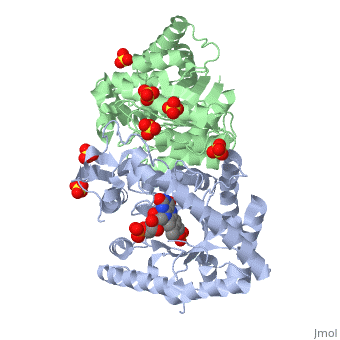User:Mitchell Long/Sandbox 1
From Proteopedia
| Line 9: | Line 9: | ||
<p>FMNH<sub>2</sub>+O<sub>2</sub>+RCHO→FMN+RCOOH+H<sub>2</sub>O+hv(490nm)</p> | <p>FMNH<sub>2</sub>+O<sub>2</sub>+RCHO→FMN+RCOOH+H<sub>2</sub>O+hv(490nm)</p> | ||
| - | The catalytic α subunit houses the FMN cofactor and is connected to the β subunit via a hairpin structure called the "<scene name='User:Mitchell_Long/Sandbox_1/Protease_labile_region/3'> | + | The catalytic α subunit houses the FMN cofactor and is connected to the β subunit via a hairpin structure called the "<scene name='User:Mitchell_Long/Sandbox_1/Protease_labile_region/3'>Mobile loop</scene>." The organic substrate for bacterial luciferase in vivo is myristic aldehyde, although many aliphatic aldehydes of various lengths can induce bioluminescence in vitro. |
| - | <scene name='User:Mitchell_Long/Sandbox_1/Luciferase_w_out_cofactor/1'> | + | <scene name='User:Mitchell_Long/Sandbox_1/Luciferase_w_out_cofactor/1'>Luciferase with no bound cofactor</scene> |
| + | |||
| + | <p><scene name='User:Mitchell_Long/Sandbox_1/Hetero_fmn_complex/1'>Luciferase+FMN</scene></p> | ||
| + | <p><scene name='User:Mitchell_Long/Sandbox_1/Hetero_fmn_complex_translucent/1'>FMN Positioning</scene></p> | ||
| - | <scene name='User:Mitchell_Long/Sandbox_1/Hetero_fmn_complex_translucent/1'>FMN Positioning</scene> | ||
| - | <scene name='User:Mitchell_Long/Sandbox_1/Hetero_fmn_complex/1'>Luciferase+FMN</scene> | ||
==Structural Motifs== | ==Structural Motifs== | ||
Revision as of 20:52, 17 November 2011
| |||||||||||
| |||||||||
| 3fgc, resolution 2.30Å () | |||||||||
|---|---|---|---|---|---|---|---|---|---|
| Ligands: | , , | ||||||||
| Gene: | luxA (Vibrio harveyi), luxB (Vibrio harveyi) | ||||||||
| Activity: | Alkanal monooxygenase (FMN-linked), with EC number 1.14.14.3 | ||||||||
| Related: | 1luc, 1brl | ||||||||
| |||||||||
| |||||||||
| Resources: | FirstGlance, OCA, RCSB, PDBsum | ||||||||
| Coordinates: | save as pdb, mmCIF, xml | ||||||||
Applications In Biotechnology
Luciferases are most commonly used as reporter genes by transduction or transfection assays. Reporter genes are inserted into an organism with a gene of interest. This is a powerful method of measuring gene expression because it is non-invasive. Genes for luciferase can paired with an inducible operon. When the gene for luciferase and the gene of interest are incorporated into the host genome, they can "turned on" by induction. Once the desired gene is turned on, gene expression can be determined by the intensity of the light produced by transcription of the gene of interest.
Quorum Sensing
In a process known as quorum sensing, bacteria communicate using secreted signal molecules called autoinducers(AIs). V. harveyi is a mesophilic, gram negative, rod shaped bacteria that can communicate with other bacteria via quorum sensing. Quorum-sensing bacteria alter gene expression in response to the accumulation of AIs, which reflects an increase in cell population density. This process is believed to provide bacteria a means to coordinately control the gene expression of the group, giving them multicellular characteristics. When bacteria reach a "quorum," their population has reached a density high enough to coordinate gene expression. Often, bacteria make and respond to multiple AIs. Vibrio harveyi, a free-living marine bacterium, produces at least three distinct AIs to control bioluminescence, biofilm formation, Type III Secretion (TTS), and protease production. When a bacterial population density is low, the LuxI gene is transcribed constitutively at basal level. The three V. harveyi AIs are HAI-1, an acyl homoserine lactone; AI-2, a furanosyl-borate-diester; and CAI-1, of unknown structure. When the population density reaches an adequate level, the conjugate receptor LuxR begins transcription. LuxR is the regulatory receptor, and when an AI binds the the LuxR receptor, transcription is turned on resulting in the production of more AI and the expression of other genes involved in quorum sensing. When V. harveyi reaches a high enough population density, it's quorum sensing genes are activated and the transcription of the genes that code for the luciferase enzyme.


